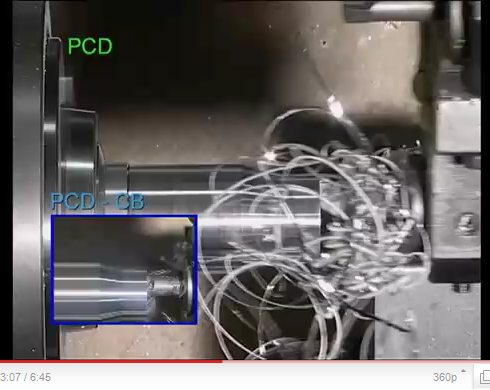Dear Shop Doc,
We are running a long aluminum part on our CNC Swiss and are having problems with long stringy chips building up in the machine that are getting wrapped around the part. We’ve tried every “aluminum” insert under the sun and have 2,000 psi coolant, but nothing works. Please help!
Tangled Up in Tennessee
Dear Tangled,
There is a new chip control technology for aluminum that I’ve found to be very effective. It’s a PCD (polycrystalline diamond) insert that has a 3D chipbreaker. Up until now, manufacturers have been unable to produce 3D chipbreakers in the ultra-hard polycrystalline diamond material. A new process has been developed that uses a laser to etch a variety of 3D chipbreaker shapes into the PCD. The inserts are made by Becker Diamont. They have a video on YouTube that can be found at: http://www.youtube.com/watch?v=gLRJdMDvbpY.
A brochure can be downloaded at: http://www.ranitool.com/ChipBreaker-rani-lowres.pdf.
On a Swiss I’ve found that the feed rate is critical to getting the chip to break. In general a heavier depth of cut requires a slightly higher feed rate. On a fixed headstock lathe, you can also vary the depth of cut as well as the feed rate to obtain optimum results.
Other possible solutions include milling a flat or a narrow slot along the length of the cut before turning. I prefer to use a narrow slotting saw to cut a slot off center along the turn length. The narrow slot leaves less chance of generating an out of round condition on the turned diameters. Milling the slot off of the centerline of the work prevents the slot from hitting the turning insert squarely. The slot being off center along with the rotation of the work causes the slot to hit the insert and travel by it on an angle. This eliminates any pounding caused by the interruption while providing enough interruption to break the chip.
Problems with grooving and cutoff tools can often be solved by using a peck cycle like G75, which is like a peck drilling cycle, but from the cross axis rather than along the Z-axis.
Ultimately these other options add cycle time while the PCD insert will likely reduce cycle time while improving uptime. You will pay more for PCD, but it almost always costs less than a polished carbide insert due to the vastly improved tool life.
Another added benefit is that once you start breaking the chips up, you won’t have to empty out the chip bin nearly as often. Those long wiry chips create big air pockets that take up a lot of space.
–Dan Murphy
Tsugami REM Sales
Dan Murphy is a regional sales manager for Rem Sales LLC., a U.S. Tsugami importer. He can be reached at dmurphy@remsales.com.


1 Comment
Have you tried to program a, G74 Z-?- F?- Q?- R100, this will break the chips on a linear move .
also a G75 for a peck part off.
I have uses these canned cycles for years , you can control the chip by the Q value (Q74)
and by the P value ( G75)
joe